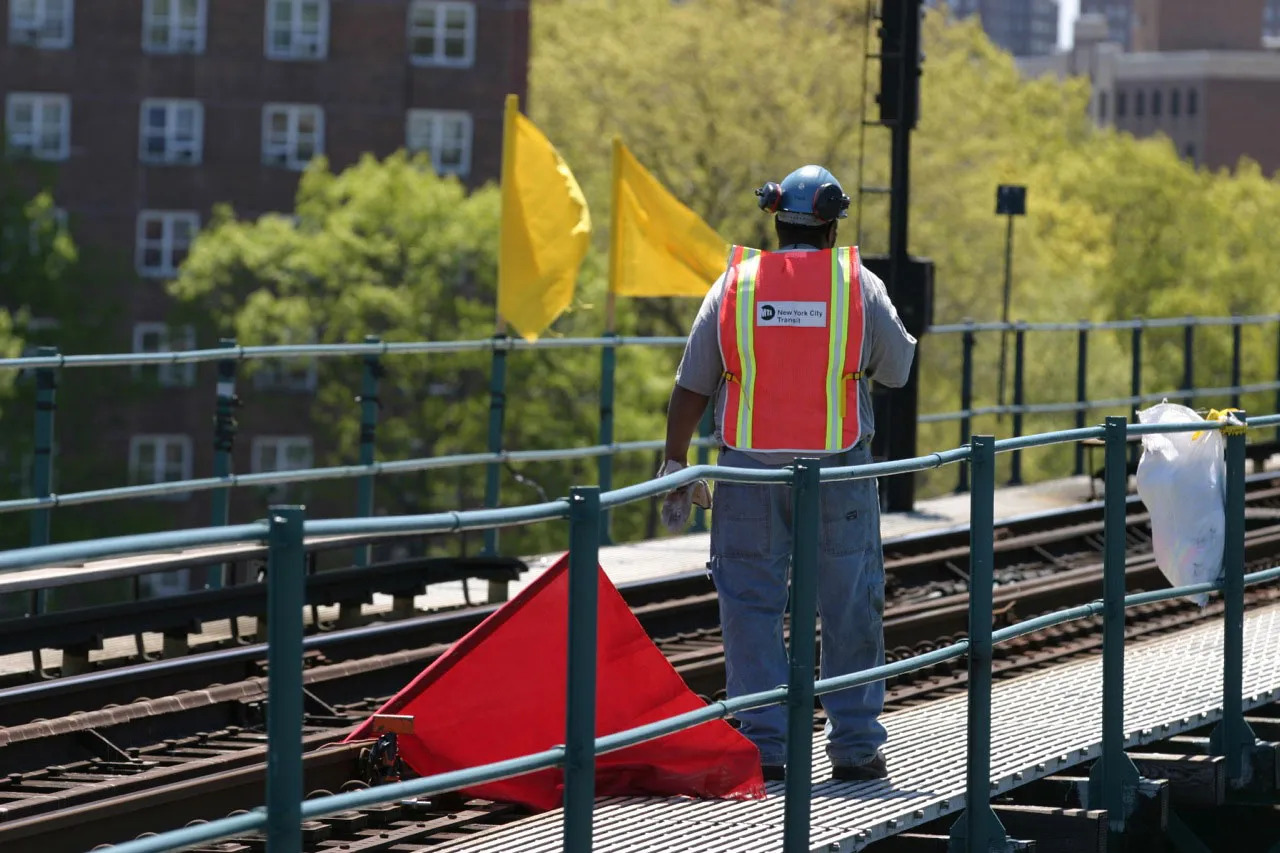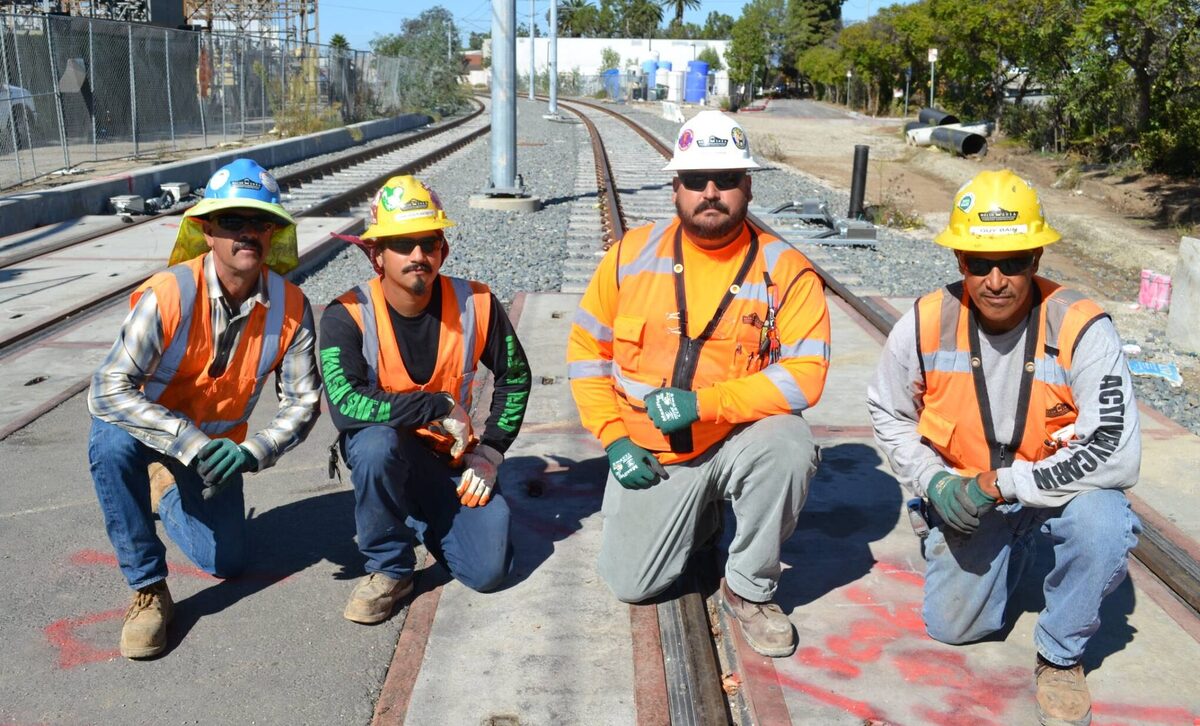Home>diy>Building & Construction>What Is Flagging In Construction


Building & Construction
What Is Flagging In Construction
Modified: January 5, 2024
Discover what flagging in construction means and how it is relevant to building construction projects. Uncover the importance of flagging in ensuring safety and compliance.
(Many of the links in this article redirect to a specific reviewed product. Your purchase of these products through affiliate links helps to generate commission for Storables.com, at no extra cost. Learn more)
Introduction
In the realm of construction, there are numerous safety measures that must be adhered to in order to ensure the well-being of workers and the proper execution of projects. One such safety measure is the use of flagging. Flagging plays a crucial role in construction sites by providing visual signals and guidance to workers, pedestrians, and drivers.
Flagging in construction involves the strategic placement of cloth flags, cones, or other visible markers to indicate potential hazards, direct traffic flow, and communicate important information. This important practice helps to minimize accidents, control traffic movement, and maintain order and safety at construction sites.
By understanding the definition, types, importance, uses, guidelines, and benefits of flagging in construction projects, professionals in the industry can ensure that it is effectively implemented and maximizes safety.
Throughout this article, we will delve deeper into the world of flagging in construction, exploring its significance, techniques, and challenges faced by construction workers and site managers. Whether you’re an experienced construction professional or simply interested in learning about the complexities of construction site safety, this article will provide valuable insights into the world of flagging.
Key Takeaways:
- Flagging in construction is a vital safety measure that enhances visibility, controls traffic flow, and minimizes accidents. It plays a crucial role in maintaining order and ensuring the safety of workers, pedestrians, and drivers within construction sites.
- Proper flagging techniques, including clear communication, effective traffic flow management, and enhanced visibility, are essential for navigating construction zones safely and efficiently. Adhering to flagging guidelines and regulations is crucial for maintaining a high level of safety and minimizing risks.
Read more: What Material Is Best For Outdoor Flags
Definition of Flagging in Construction
In the construction industry, flagging refers to the practice of marking and delineating specific areas or hazards using visible indicators such as cloth flags, cones, barricades, or other highly visible materials. The primary purpose of flagging in construction is to ensure the safety of workers, the general public, and to maintain order and control at construction sites.
Flagging is typically used in situations where there is a need to redirect or control the movement of vehicles or pedestrians. It helps to communicate vital information and warn people about potential risks or dangers in the construction zone. By clearly marking different areas or hazards, flagging helps to minimize accidents, prevent injuries, and promote a safe working environment.
Flagging in construction can be categorized into two main types: temporary flagging and permanent flagging. Temporary flagging is used during the construction process and is typically removed once the project is completed. Permanent flagging, on the other hand, is used for long-term purposes and remains in place as a permanent fixture even after the construction project is finished.
Flagging is a crucial component of construction site safety, as it provides clear visual cues to workers, drivers, and pedestrians, helping them navigate through the construction zone safely and efficiently. It acts as a visual guide, directing the flow of traffic and preventing confusion or accidents caused by lack of direction or communication.
Overall, the practice of flagging in construction plays a vital role in maintaining safety and order at construction sites. By effectively implementing flagging techniques, construction professionals can ensure the well-being of everyone involved in the project and minimize the risk of accidents and mishaps.
Types of Flagging Used in Construction
Flagging in construction involves the use of various types of visible markers to indicate different hazards, provide directions, and ensure the safety of workers and the general public. Let’s explore some of the common types of flagging used in construction:
- Cloth flags: Cloth flags are one of the most common types of flagging materials used in construction. These flags are usually brightly colored, such as fluorescent orange or yellow, and are attached to a pole or staff. Cloth flags are lightweight, portable, and easily recognizable, making them ideal for marking specific areas or hazards on construction sites.
- Cones: Cones are another popular type of flagging used in construction. These conical markers are typically made of durable and highly visible materials, such as PVC or rubber. Cones are easily stackable and visible from a distance, making them effective for redirecting traffic, cordoning off areas, or indicating potential hazards. They are often used to mark changes in road conditions or to guide traffic safely around construction zones.
- Barricades: Barricades are large, solid structures used for more significant barriers and to create physical dividers on construction sites. These durable barriers are typically made of plastic or metal and are highly visible to drivers and pedestrians. Barricades are commonly used to prevent access to restricted areas, create clear boundaries, or provide a physical barrier to protect workers from potential dangers.
- Tape: Flagging tape, also known as caution tape or barrier tape, is another commonly used type of flagging material in construction. This tape is usually brightly colored and made of durable, non-adhesive plastic. It is often used to mark off areas that are temporarily off-limits or to indicate potential hazards such as low-hanging objects, uneven surfaces, or construction work in progress.
- Electronic flagging: With advancements in technology, electronic flagging systems have also emerged in the construction industry. These systems use LED lights or digital signage to indicate potential hazards, direct traffic, or provide important messages. Electronic flagging offers increased visibility and can be programmed to display specific messages based on the construction site’s needs.
These are just a few examples of the types of flagging used in construction. The choice of flagging material depends on various factors such as the nature of the construction project, the level of visibility required, and the specific safety needs of the site. Regardless of the type used, flagging plays a crucial role in ensuring safety, minimizing accidents, and maintaining order at construction sites.
Importance of Flagging in Construction
Flagging plays a vital role in construction sites and is of utmost importance for the safety of workers, the general public, and the smooth execution of construction projects. Let’s explore some key reasons why flagging is crucial in the construction industry:
- Enhancing visibility: Flagging materials such as cloth flags, cones, and barricades are highly visible and act as visual markers in construction sites. They help to increase visibility and draw attention to potential hazards or changes in the environment. This visibility is essential in preventing accidents or injuries by ensuring that workers, pedestrians, and drivers are aware of their surroundings.
- Controlling traffic flow: Construction sites often involve the movement of vehicles and pedestrians, which can lead to congestion or potential accidents. Flagging helps to control traffic flow by providing clear directions and indicators for drivers. This helps to prevent confusion, maintain order, and ensure the safe movement of vehicles within the construction zone.
- Minimizing accidents and injuries: The construction industry is inherently risky, with numerous hazards present on a daily basis. Flagging plays a crucial role in minimizing accidents and injuries by clearly marking hazardous areas or potential risks. This allows workers to take necessary precautions and helps to prevent unintentional entry into dangerous zones by unauthorized individuals.
- Warning of potential hazards: Construction sites often have various hazards such as loose debris, open excavations, or falling objects. Flagging materials, such as caution tape or barricades, are used to signal these hazards and warn workers and passersby. Clear and visible flagging helps to create awareness and prompt individuals to exercise caution when entering or passing through the construction site.
- Guiding emergency response: In the event of an emergency, clear flagging helps to guide emergency responders to the specific location. By marking emergency exits, access points, or important areas, flagging ensures that emergency services can navigate the construction site quickly and efficiently, potentially saving lives and minimizing damage.
The importance of flagging in construction cannot be overstated. It serves as a crucial tool for maintaining safety, promoting order, and preventing accidents and injuries. By implementing effective flagging techniques and adhering to industry guidelines, construction professionals can create a safer work environment and ensure the successful completion of construction projects.
Uses of Flagging in Construction Projects
Flagging is utilized in a wide range of applications within construction projects, providing visual signals and guidance to workers, pedestrians, and drivers. Let’s explore some common uses of flagging in construction:
- Marking work zones: Flagging is commonly used to mark off specific work zones within a construction site. By using cloth flags, cones, or barricades, construction workers can clearly delineate areas where they are actively working. This helps to control access and prevent unauthorized individuals from entering hazardous zones.
- Directing traffic: Flagging plays a crucial role in directing vehicular and pedestrian traffic within construction sites. By strategically positioning flaggers or using visible markers such as cones or electronic flagging systems, construction workers can guide traffic, indicate detours, or redirect vehicles away from construction areas. This helps to ensure the safe movement of vehicles and pedestrians and mitigate traffic congestion.
- Warning of hazards: Construction sites are often filled with potential hazards that can pose risks to workers and the general public. Flagging materials are used to warn individuals about these hazards, such as open excavations, uneven surfaces, or falling objects. By placing caution tape or visible markers, flagging helps to create awareness and prompt caution in areas with potential dangers.
- Indicating changes in road conditions: During road construction projects, flagging is used to indicate changes in road conditions, such as temporary lane closures, road diversions, or detours. This helps to ensure the safety of drivers by providing clear instructions on how to navigate through the construction zone and avoid potential dangers.
- Designating clear pathways: In construction sites with heavy equipment and machinery, it’s essential to establish safe pathways for workers and pedestrians. Flagging is used to mark designated pedestrian walkways, vehicle routes, and equipment access points. This helps to prevent accidents caused by the inadvertent crossing of pathways and ensures a clear separation between workers and machinery.
The uses of flagging in construction projects are diverse and crucial to maintaining safety and efficiency. Whether it’s marking work zones, directing traffic, warning of hazards, or designating clear pathways, flagging is an invaluable tool that helps to navigate the complexities of construction sites while mitigating risks and ensuring the well-being of everyone involved.
Flagging in construction is the process of marking or identifying potential hazards, work areas, or boundaries using brightly colored flags. It helps to improve safety and communication on the job site.
Read more: How To Store Flags
Flagging Guidelines and Regulations in the Construction Industry
The use of flagging in the construction industry is regulated by various guidelines and regulations to ensure the safety of workers, pedestrians, and drivers. Compliance with these guidelines is essential to maintain order, prevent accidents, and minimize risks. Let’s explore some of the key flagging guidelines and regulations in the construction industry:
- Color and Visibility: Flagging materials must be highly visible and easily distinguishable from the surrounding environment. Generally, bright colors such as fluorescent orange or yellow are recommended for maximum visibility. It’s crucial to ensure that the flagging materials used meet the required visibility standards set by regulatory bodies.
- Placement and Spacing: Flagging should be strategically placed to effectively communicate warnings, instructions, or hazards to workers, pedestrians, and drivers. The spacing between flagging markers should be appropriate to provide clear and consistent guidance. Proper placement ensures that the intended message is conveyed accurately and helps to prevent confusion.
- Training and Certification: Flaggers responsible for directing traffic or managing flagging operations should undergo specialized training and certification programs. These programs provide valuable knowledge on flagging techniques, proper use of flagging materials, and understanding traffic control principles. Certification helps to ensure that flaggers are competent and capable of safely managing traffic flow.
- Signage and Communication: In addition to flagging materials, appropriate signage and communication systems should be in place to provide clear instructions and information. This can include the use of signs, electronic message boards, or audible warnings to communicate important messages to workers, pedestrians, and drivers within the construction zone.
- Compliance with Local Regulations: Each jurisdiction may have specific regulations and requirements regarding flagging in construction. It is essential to familiarize oneself with the local regulations and ensure compliance. This may include obtaining permits, following specific flagging protocols, or adhering to specific safety standards established by local authorities.
By adhering to these flagging guidelines and regulations, construction professionals can ensure that flagging operations are conducted safely and effectively. Regular inspections and evaluations of flagging practices should be conducted to identify any potential issues or areas for improvement. With proper flagging protocols in place, construction sites can maintain a high level of safety and minimize risks for all involved.
Proper Techniques for Flagging in Construction
Flagging in construction requires proper techniques to ensure effective communication, maximize visibility, and maintain safety. Here are some key techniques to consider when implementing flagging in construction:
- Positioning: Proper positioning of flaggers and flagging materials is crucial for clear communication and visibility. Flaggers should be positioned in areas with the best line of sight to approaching traffic, ensuring that they can effectively relay instructions and warnings. Flagging materials, such as cloth flags or cones, should be placed at appropriate locations to provide clear visual cues to drivers and pedestrians.
- Motion and Gestures: Flaggers must use specific motions and gestures to convey instructions to drivers. Standardized hand signals, such as holding the flag horizontally to indicate “Stop” or diagonally to indicate “Proceed with Caution,” should be used consistently. Clear and deliberate motions help to ensure quick comprehension by drivers and assist in maintaining traffic flow.
- Clear and Concise Communication: Flaggers should communicate with drivers in a clear and concise manner. Using a strong and confident voice, flaggers can provide verbal instructions or warnings to drivers when necessary. It’s important to avoid excessive chit-chat or distractions that may interfere with effective communication and compromise safety.
- Proper Use of Flagging Materials: Flagging materials should be used correctly to maximize visibility. Cloth flags should be securely attached to a staff or pole, ensuring they remain upright and easily visible. Cones or barricades should be placed in a way that clearly marks hazards or redirects traffic. Regular inspection of flagging materials is important to ensure they are in good condition and highly visible.
- Teamwork and Coordination: Proper flagging operations require teamwork and coordination among multiple flaggers, especially in larger construction sites. Flaggers should communicate with each other to ensure consistent instructions and seamless traffic flow. Clear lines of sight between flaggers and the use of radios or other communication devices can facilitate effective coordination.
It is also essential to stay up to date with industry best practices and any changes to flagging guidelines or regulations. Regular training and refresher courses can help flaggers stay current with proper flagging techniques and safety protocols.
By implementing these proper techniques for flagging in construction, workers, pedestrians, and drivers can navigate construction zones safely and efficiently. Effective flagging practices promote order, minimize confusion, and enhance overall construction site safety.
Benefits of Using Flagging in Construction Projects
Flagging is a critical practice in construction projects that offers numerous benefits for workers, pedestrians, and the overall execution of the project. Let’s explore some of the key benefits of using flagging in construction:
- Enhanced Safety: The primary benefit of flagging is the enhanced safety it provides. By clearly marking hazards, directing traffic, and communicating important information, flagging helps to minimize accidents and injuries in construction zones. It ensures that workers, pedestrians, and drivers are aware of potential risks and can navigate the area safely.
- Improved Order and Control: Flagging establishes order and control in construction sites by managing traffic flow and guiding individuals through designated routes. It helps to prevent congestion, maintain smooth operations, and reduce the likelihood of accidents caused by confusion or lack of direction. By providing clear instructions, flagging promotes a more organized and efficient work environment.
- Increased Visibility: Flagging materials, such as cloth flags and cones, are highly visible, making them effective in drawing attention to potential hazards or changes in the environment. When used correctly, flagging materials significantly improve visibility for workers, pedestrians, and drivers, reducing the risk of collisions and accidents caused by reduced visibility in construction sites.
- Clear Communication: Flagging serves as a visual language that communicates important messages to individuals within the construction zone. It provides clear instructions, warnings, or notifications about potential hazards, changes in road conditions, or restricted access areas. This clear communication helps to prevent misunderstandings and ensures that everyone can navigate the construction site safely.
- Efficient Traffic Flow Management: Construction sites often involve the movement of vehicles and pedestrians. Effective flagging techniques help to manage traffic flow by providing clear guidance, redirecting vehicles when necessary, and minimizing disruptions caused by construction work. This ensures a smooth and efficient traffic flow, reducing delays and preventing accidents.
The benefits of using flagging in construction projects are significant and contribute to the overall safety, organization, and efficiency of the site. By implementing proper flagging practices and adhering to industry guidelines, construction professionals can create a secure work environment, reduce risks, and ensure the successful completion of projects.
Common Challenges and Issues in Flagging in Construction
While flagging is an essential safety measure in construction, it is not without its challenges and issues. Construction professionals must be aware of these challenges and address them effectively to maintain the efficacy of flagging practices. Let’s explore some of the common challenges and issues in flagging in construction:
- Visibility in adverse weather conditions: Inclement weather conditions such as heavy rain, fog, or snow can reduce the visibility of flagging materials and make it challenging for workers and drivers to see the designated markers. This can potentially lead to confusion or accidents. Additional precautions, such as using reflective materials or utilizing electronic signage, may be necessary in adverse weather conditions.
- Driver compliance: Despite the presence of flagging and clear instructions, some drivers may fail to comply with the instructions given. This can occur due to distractions, negligence, or a lack of awareness. Construction professionals must employ additional measures, such as visible signage, traffic calming devices, or law enforcement presence, to reinforce flagging instructions and encourage driver compliance.
- Pedestrian management: Flagging is not only about directing vehicular traffic but also involves managing pedestrians within the construction site. It can be challenging to control and guide pedestrians, especially in areas with heavy foot traffic. Proper communication, clear signage, designated pedestrian walkways, and flaggers stationed at key points can help mitigate pedestrian-related challenges.
- Work zone intrusion: Unauthorized individuals or vehicles may attempt to enter restricted areas within the construction site, disregarding the flagging and safety protocols in place. Intrusions pose a significant risk to both intruders and construction workers. Construction site managers must implement robust security measures, such as fencing, surveillance, and access controls, to prevent unauthorized access and protect the integrity of the work zone.
- Flagger safety: Flaggers themselves face potential risks and hazards while carrying out their flagging duties. They are often positioned close to moving traffic, exposing them to the danger of being struck by passing vehicles. Proper training, the use of high-visibility personal protective equipment, and the provision of physical barriers or buffer zones can help protect flaggers and mitigate the risks they face.
Addressing these challenges and issues requires a proactive approach, ongoing training, and a commitment to continuously improving flagging practices. Regularly assessing and updating flagging procedures, providing proper equipment and resources, and maintaining open lines of communication among workers and flaggers can help overcome these challenges and ensure the effectiveness of flagging in construction.
Read more: What Is The Best Outdoor Flag Material
Conclusion
Flagging is an indispensable safety measure in the construction industry. It plays a crucial role in maintaining order, enhancing visibility, and ensuring the safety of workers, pedestrians, and drivers within construction sites. By utilizing flagging materials and implementing proper flagging techniques, construction professionals can effectively communicate important messages, control traffic flow, and minimize accidents and injuries.
Throughout this article, we have explored the definition of flagging in construction, the various types of flagging materials used, and the importance of flagging in ensuring safety and order. We have also discussed the uses of flagging in construction projects, the guidelines and regulations that govern flagging practices, and the proper techniques that should be employed when implementing flagging operations. Additionally, we have highlighted the benefits that flagging brings to construction sites in terms of safety, communication, and traffic management.
However, it is important to acknowledge the challenges and issues that can arise in flagging practices. From difficulties in maintaining visibility during adverse weather conditions to ensuring driver compliance and effectively managing pedestrians, construction professionals must be prepared to address these challenges and implement measures to mitigate risks. Additionally, the safety of flaggers themselves must be prioritized through proper training, personal protective equipment, and the provision of secure work environments.
In conclusion, flagging is a vital component of construction site safety. By adhering to flagging guidelines and regulations, employing proper techniques, and addressing common challenges, construction professionals can enhance safety, maintain order, and ensure the successful execution of construction projects. Continued vigilance, regular training, and a commitment to improvement are essential to keep flagging practices effective and to protect the well-being of everyone involved in construction activities.
Frequently Asked Questions about What Is Flagging In Construction
Was this page helpful?
At Storables.com, we guarantee accurate and reliable information. Our content, validated by Expert Board Contributors, is crafted following stringent Editorial Policies. We're committed to providing you with well-researched, expert-backed insights for all your informational needs.














0 thoughts on “What Is Flagging In Construction”